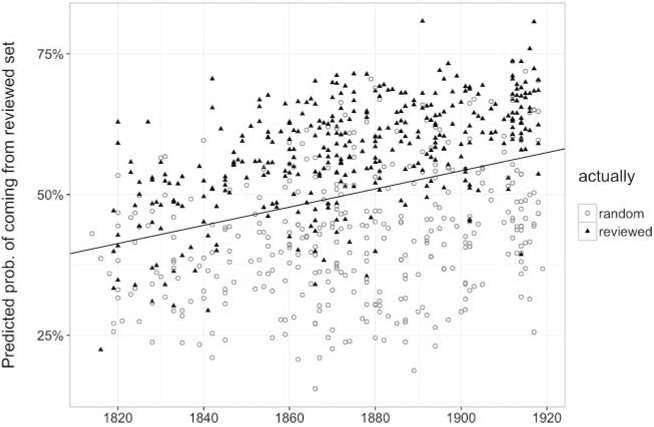The Longue Durée of Literary Prestige
Ted Underwood,Jordan Sellers +1 more
Reads0
Chats0
TLDR
The authors studied the stylistic differences associated with literary prominence across a century and found that there is a steady tendency for new volumes of poetry to change by slightly exaggerating certain features that defined prestige in the recent past.Abstract:
A history of literary prestige needs to study both works that achieved distinction and the mass of volumes from which they were distinguished. To understand how those patterns of preference changed across a century, we gathered two samples of English-language poetry from the period 1820–1919: one drawn from volumes reviewed in prominent periodicals and one selected at random from a large digital library (in which the majority of authors are relatively obscure). The stylistic differences associated with literary prominence turn out to be quite stable: a statistical model trained to distinguish reviewed from random volumes in any quarter of this century can make predictions almost as accurate about the rest of the period. The “poetic revolutions” described by many histories are not visible in this model; instead, there is a steady tendency for new volumes of poetry to change by slightly exaggerating certain features that defined prestige in the recent past.read more
Figures
Citations
More filters
Elements Of Style
Abstract: Thank you for downloading elements of style. As you may know, people have search hundreds times for their chosen novels like this elements of style, but end up in malicious downloads. Rather than reading a good book with a cup of coffee in the afternoon, instead they are facing with some infectious bugs inside their desktop computer. elements of style is available in our digital library an online access to it is set as public so you can download it instantly. Our digital library spans in multiple locations, allowing you to get the most less latency time to download any of our books like this one. Merely said, the elements of style is universally compatible with any devices to read.
Journal ArticleDOI
The Equivalence of “Close” and “Distant” Reading; or, Toward a New Object for Data-Rich Literary History
Proceedings ArticleDOI
A Genre-Aware Attention Model to Improve the Likability Prediction of Books
TL;DR: A novel multimodal neural architecture that incorporates genre supervision to assign weights to individual feature types based on the characteristics of each book and achieves competitive results and even outperforms state-of-the-art for this task.
Journal ArticleDOI
Distributed Character: Quantitative Models of the English Stage, 1550–1900
TL;DR: The concepts offered by quantitative analyses operate across scales in ways that are often foreign to literary study They demand new kinds of abstraction: ones that can take into account minute effects in single texts replicated across a corpus that numbers in the hundreds, or thousands as discussed by the authors.
References
More filters
Journal ArticleDOI
What Is Sentimentality
TL;DR: The authors argue that scholarly usages of sentimentality are more closely intertwined with everyday meanings of the term than we usually recognize, that they often rely on unexamined and untenable assumptions about the nature of emotion and that intermittent slides into condemnation or celebration undermine their analytic value.
Journal ArticleDOI
Meaning and mining: the impact of implicit assumptions in data mining for the humanities
D. Sculley,Bradley M. Pasanek +1 more
TL;DR: It is argued that in the digital humanities, the standards for the initial production of evidence should be even more rigorous than in the empirical sciences because of the subjective nature of the work that follows.
Journal ArticleDOI
Literary Pattern Recognition: Modernism between Close Reading and Machine Learning
Hoyt Long,Richard Jean So +1 more
TL;DR: The authors propose a model of reading literary texts that synthesizes familiar humanistic approaches with computational ones, such as topic modeling and network analysis, to expose macroscale patterns of language and form culled from massive digitized literary corpora.
A Quantitative Literary History of 2,958 Nineteenth-Century British Novels : The Semantic Cohort Method
Ryan Heuser,Long Le-Khac +1 more
TL;DR: The authors report on a long-term experiment in tracing such macroscopic changes in the novel during this crucial period and reveal a systemic concretization in language and fundamental change in the social spaces of the novel.



